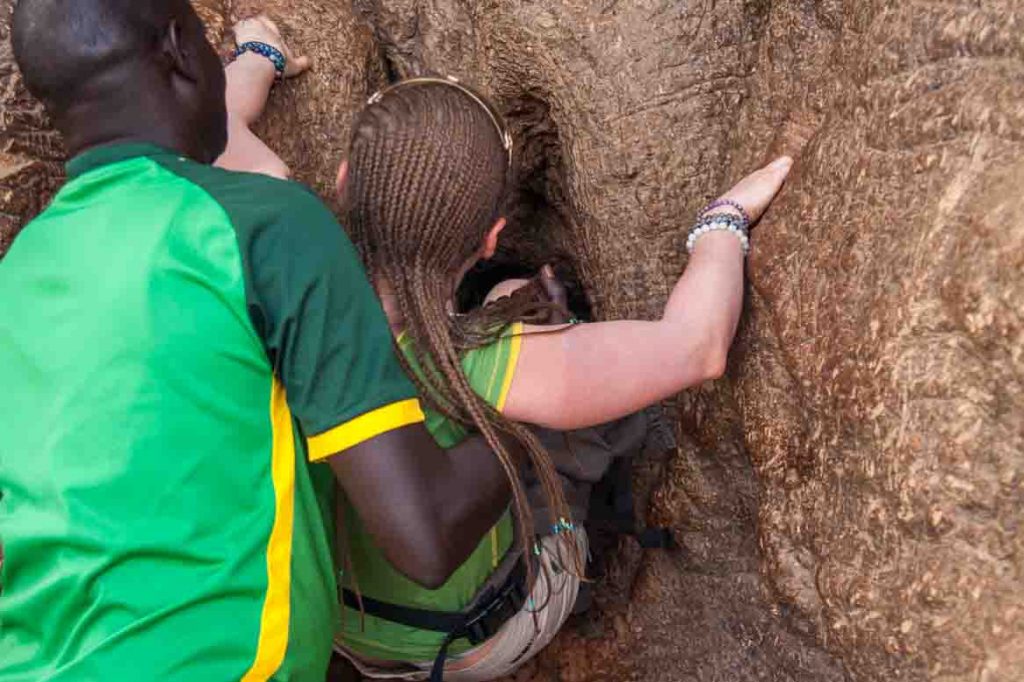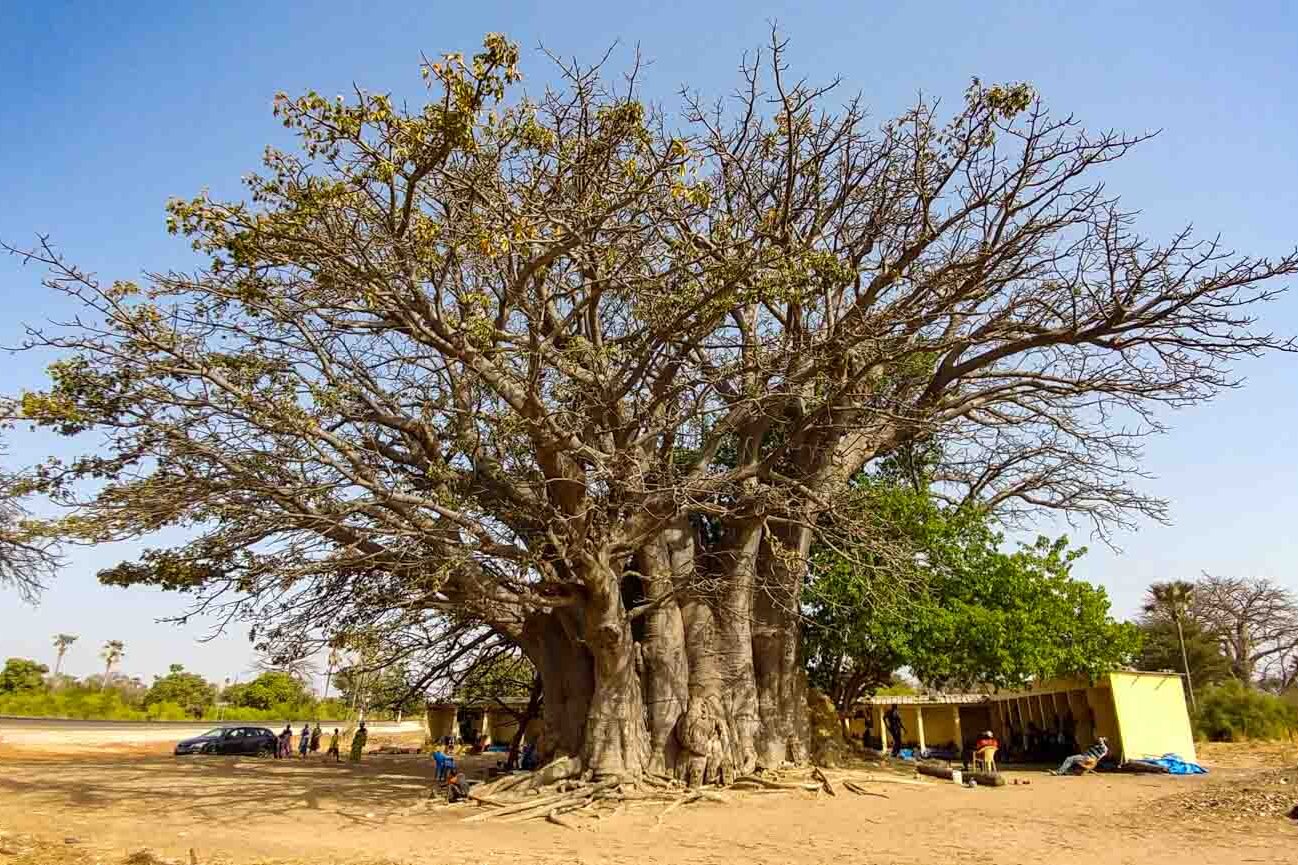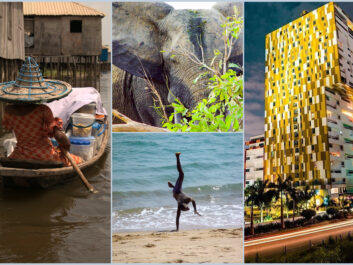Away from the big cities of Africa, you can admire vast lands scattered with small villages. Nature, trees in particular, has a special place in the African culture. Among the African trees, the baobab is probably the most iconic.
In Senegal, West Africa, you can see baobab trees everywhere. They are part of the landscape of cities as well as rural areas. Villages and backyards are built around these majestic trees. Senegalese love baobabs and believe they are sacred. Sacred baobab trees are often central to the life of villagers who ask the spirit of the tree for good fortune, health, or success.
There is something magical about the baobabs when they grow old, sometimes the tissue inside the trees dies, leaving behind a big hole. For big trees, these holes are like caves and are big enough to accommodate several people.
Fadiouth, The Shell Island
During my last trip to Senegal, My mother, wife, daughter and I visited Joal-Fadiouth, a small town on the coast south of Mbour. The town comprises the village of Joal on the mainland and the island of Fadiouth. Joal is famous for being the birthplace of Senegal’s first president Léopold Sédar Senghor. However, the main attraction is Fadiouth, the shell island. Fond of seafood, the inhabitants on the coast threw empty shells in the water for many centuries. With time, the shells formed an island where people settled. Shells also dot the walls on some of the houses built on the island.

You can reach the island with a short pirogue ride or by a long wooden bridge. Walking on the bridge, you come across children going to school, women carrying something on their heads, or men slowly making their way to the other side. The ban on motorized vehicles gives the island a calm and peaceful atmosphere allowing for enjoyable strolls. A few street vendors display the local craft on tables or doors to attract potential buyers. From the narrow streets, it is easy to spot the scenes of everyday life: old men playing checkers in the shade, a few children playing soccer, a pig searching for food in the shallow water. On the main square stands the sacred baobab tree. The dry season left it without its leaves. Its branches reach for the sky in a multitude of directions. A few centuries old, the tree calls you. In order to communicate with its spirit, we have to touch the trunk with the left hand, the hand of the heart. So we do, the 3 of us.
In a country where the main religion is Islam, Fadiouth island is an exception. 90% of the population is Christian. They live peacefully with Muslims, a rare occurrence in this world. Community living is best represented by the cemetery where both Muslim and Christian graves share the land. The cemetery lies on another island also made of shells linked to Fadiouth by a second bridge.
Inside The Sacred Baobab Tree In Fadial
Leaving Joal-Fadiouth on the road to Samba Dia, relaxed by the pleasant stop, we arrive at the sacred baobab tree in the village of Fadial, one of the biggest in the country. I was told that the tree is 850 years of age. When you stand in front of such a monumental tree, the only thing you can do is admire the work of nature. The trunk is so large that it allows for dozens of people to sit around its foot. The long roots, popping from the ground make convenient seats for the villagers. From afar, the trunk of the baobab resembles that of several trees standing next to each other, but as you approach the tree, you realize that it is only one trunk. You feel so small, but at the same time very pleased to witness such a marvel.

Nowadays, it is possible to enter the tree through a hole that is just big enough to let one person squeeze through. We went inside the tree. The insides are like those of a small room with a very high ceiling. On top, plenty of bats hang while sleeping, and yes, they occasionally poop on you. My daughter does not like the company of the bats and leaves us after a short while. My wife and I, amazed to be inside a tree, enjoy the moment, touching the tree, feeling the presence of its spirit. It is such an incredible experience to be inside this sacred tree knowing it used to preserve the remains of griots. The way out of the tree is an experience in itself. Because the hole is narrow and too high to put your legs in first, you have to put your head in instead. Half-way through, you need to turn your body and push yourself out. You will also need the people outside the tree to help pull you out. This is described by the locals as a second birth. Indeed, this is the type of experience that makes you understand the local culture and will inspire you for the rest of your life. On your next trip to Africa, pay attention to the trees and do not forget to honor the king of them all, the baobab tree.
The Guardian Of The Griots’ Knowledge
Old baobabs with a hole in their trunks were previously used for a peculiar reason. The bodies of deceased griots—the storytellers, singers, musicians, keeper of knowledge in West Africa—used to be preserved in these hollow trees. As they were considered to be wise men, griots could not be buried for fear that their knowledge might be lost in the ground. Instead, they were kept inside baobabs, where their knowledge could diffuse forever through the tree. After choosing a baobab tree as a mausoleum for a griot, a special ceremony was held to ask ancestors to guard the tree. Since 1962, this practice has been forbidden for public health reasons, and the remains of the griots have been removed from the trees. However, the trees are still sacred and worshiped by the local population.
All About The Baobab Tree
This tree is a symbol of strength, knowledge, and longevity. Baobab trees grow for centuries or even thousands of years. Researchers have found that some baobabs were more than 2,500 years old. In addition, baobab trees have several benefits and are used in many different ways:
- The baobab fruit, also known as monkey bread, tastes like sour candy and is extremely rich in vitamin C. This fruit is used to make juice, jam, and ice cream. The leaves of the baobab tree are also edible and are used to prepare savory meals.
- Baobabs have been used as a medicinal product for centuries. Egyptians treated fevers, dysentery, and bloody wounds with baobab powder. In West Africa, this powder is used against malaria.
- The baobab tree is huge and thus provides a lot of shade. People often gather around the tree for leisurely activities as well as town meetings. This tree is also used as a landmark, helping travelers find their way around an area.







